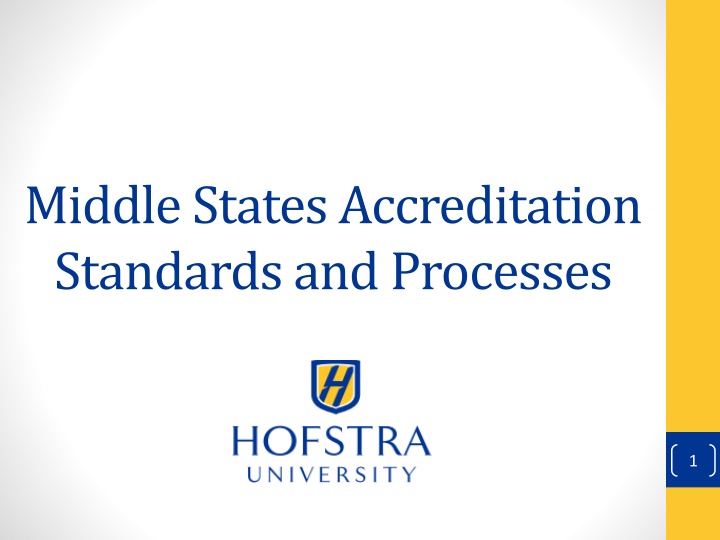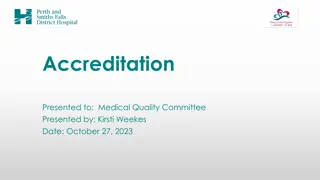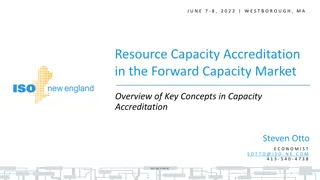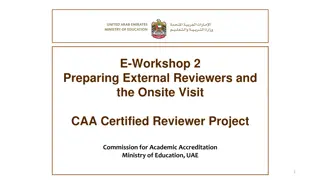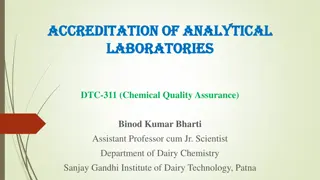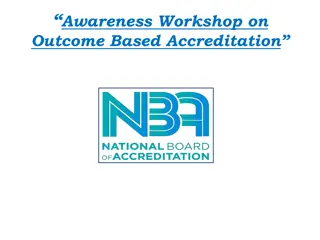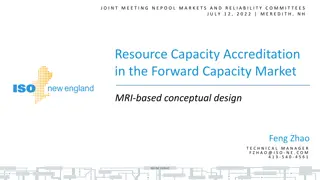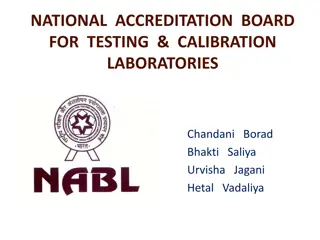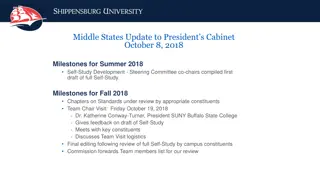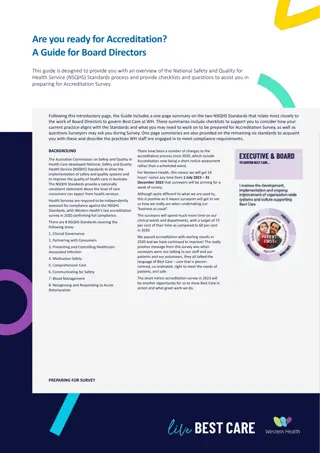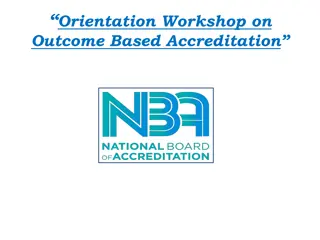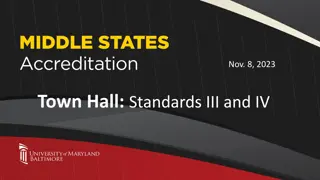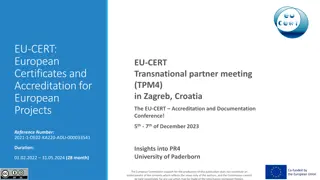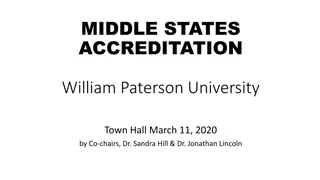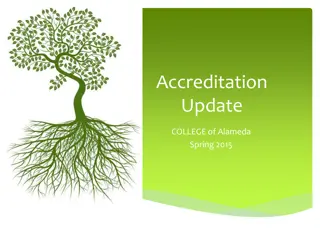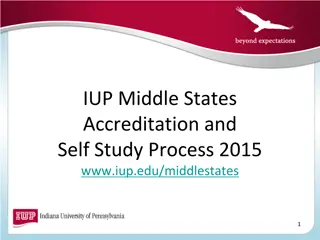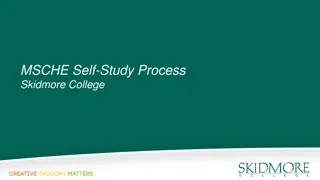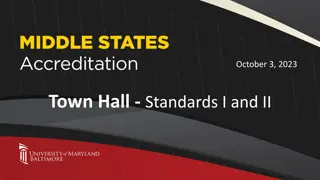Standards of Accreditation: Middle States Process & Requirements
Middle States Commission on Higher Education ensures educational quality through accreditation process emphasizing institutional accountability, improvement, innovation, and mission-centric standards. Revised standards focus on simplicity, ethics, student welfare, and governance support.
Download Presentation

Please find below an Image/Link to download the presentation.
The content on the website is provided AS IS for your information and personal use only. It may not be sold, licensed, or shared on other websites without obtaining consent from the author.If you encounter any issues during the download, it is possible that the publisher has removed the file from their server.
You are allowed to download the files provided on this website for personal or commercial use, subject to the condition that they are used lawfully. All files are the property of their respective owners.
The content on the website is provided AS IS for your information and personal use only. It may not be sold, licensed, or shared on other websites without obtaining consent from the author.
E N D
Presentation Transcript
Middle States Accreditation Standards and Processes 1
Middle States Mission Statement The Middle States Commission on Higher Education assures students and the public of the educational quality of higher education. The Commission s accreditation process ensures institutional accountability, self-appraisal, improvement, and innovation through peer review and the rigorous application of standards within the context of institutional mission. 2
Requirements of Affiliation and Standards for Accreditation Four Principles found in the Introduction (p.1) guide the foundation for our work: Mission-centric standards acknowledge the diversity of institutions Focus of the standards is on the student learning experience Standards emphasize the importance of continuous improvement Standards support innovation as essential to higher education 3 MSCHE Standards for Accreditation What you need to know [PowerPoint Slides]. Retrieved from http://www.msche.org/documents/RevisedMSCHEStandards-WhatYouNeedtoKnow.pdf
Requirements of Affiliation and Standards for Accreditation A HIGHER EDUCATION INSTITUTION Has a mission (StandardI) And lives it with integrity (Standard II) To enhance the student learning experience (Standard II) And support the overall student experience (Standard IV) THAT INSTITUTION Assesses its success in achieving that mission (Standard V) And engages in planning to strengthen its resource and improve an institution (Standard VI) By means of an effective governing process (Standard VII) 4
Requirements of Affiliation and Standards for Accreditation Revised standards = 11 pages (vs. 68) 7 standards rather than 14 Simplicity of Standards: 1-2 sentence statements; criteria Structure: centrality of mission (mentioned 20 times); ethics builds on mission; students at the front; planning and governance support the students Assessment built into every standard 5
Standards of Accreditation: 12th & 13th Editions Mapped Out 13th Edition 12th Edition Standard 1: Mission and Goals Standard 1: Mission and Goals Standard 2: Ethics and Integrity Standard 6: Integrity Standard 3: Design and Delivery of the Student Learning Experience Standard 10: Faculty Standard 11: Educational Offerings Standard 12: General Education Standard 4: Support of the Student Experience Standard 8: Student Admissions and Retention Standard 9: Student Support Services Standard 5: Educational Effectiveness Assessment Standard 13: Related Educational Activities Standard 14: Assessment of Student Learning Standard 6: Planning, Resources and Institutional Improvement Standard 2: Planning, Resource Allocation, and Institutional Renewal Standard 3: Institutional Resources Standard 7: Institutional Assessment 6 Standard 7: Governance, Leadership, and Administration Standard 4: Leadership and Governance Standard 5: Administration
Key components of the Self-Study Self-Study Narrative Focus of the Self-Study Narrative is on Institutional Improvement in the context of the standards Narrative report on Major Initiatives Identified in previous Self-Study Initiated since last Self-Study Planned future initiatives Broad in scope; having major impact on large sectors of the institution Linked specifically to appropriate Standards (note final criterion for each Standard) 8 Clark, Robert, K. Accreditation Process Change: Developing a Holistic Approach. 2016 Middle States Town Hall, http://www.msche.org/documents/Fall2016TownHallSlides.pdf
Steering Committee Led by Provost and Senior Vice President for Academic Affairs, Gail Simmons, and Senior Vice President for Planning and Administration, Pat Adamski The Steering Committee Composed of working group Chairs and others Facilitates communication between working groups Integrates findings across Standards Edits and refines the final report and determines final recommendations 9
Overview of Working Groups Our MSCHE Working Groups are organized around each Standard (7 Working Groups) and related Requirements of Affiliation Primary task for Working Groups is to determine and demonstrate that the Standards and Requirements have been met, by: Engaging in a process of discovery Gathering data Critically analyzing that data Identifying strengths and challenges Making recommendations that will further support Hofstra University s mission, goals, and strategic plans 10
Overview of Working Groups Each working group has two Co-Chairs who coordinate and support the activities of working group: Co-Chairs are also members of Steering Committee Each Working Group must Populate the Documentation Roadmap Incorporate assessment activities Document what has been learned from that assessment Suggest areas for improvement Output for each Working Groups is a written draft section of the Self-Study report for its assigned Standard The resulting narrative for each Standard tells the unique story of how Hofstra University meets that Standard in sustainable, reliable, and innovative ways 11
General comments about Working Group reports: Please limit the report to about 20 pages, excluding appendices Refer to specific elements of the Standard and Requirements of Affiliation in your discussion Consider overlap between Standards and consult with other working groups as appropriate, and note the overlap in your narrative to avoid redundancies Evaluate strengths and weaknesses in a constructive and factual tone Consider the past 10 years of Hofstra s history in your analysis, since the last full review 12
General comments about Working Group reports: Include comments on Standard elements that the Working Group believes the University could develop over time. The Steering Group will consider these comments, and versions may become recommendations in the final document. Along with other appropriate materials, please refer to the 2014 PRR and the 2008-09 Self-Study report found in the documentation folder at: S:\MSCHE 2018-19 Self Study\Documentation. Not every recommendation from the Working Groups will be included in the final report. Groups should keep a separate suggestion list for all ideas for improvement. 13
Timeline for Working Groups Apr-May May 11 Sept-Dec Working Group initial meetings MSCHE VP Liaison visit Working Group meetings to review data, outline chapters, update Documentation Roadmap Working Group first drafts due to Steering Committee Working Group meetings Working Group final drafts due to Steering Committee Review, community-wide discussion of Self- Study, and revisions; Draft to Team Evaluator Chair Self-Study due to Visiting Team Visiting Team on campus MSCHE Determination Jan 2018 Feb-Apr May 15 Fall 2018 Feb 2019 Mar-Apr June 14
Resources Logistical support: Toni Fazler, Coordinator for Events and Communication Institutional Research: Stephanie Bushey, Vice President Writer: Craig Rustici, Chair of the English Department, Professor of English Academic Assessment & Student Learning Outcomes: Terri Shapiro, Sr. Vice Provost Shared drive: S:\MSCHE 2018-19 Self Study Middle States publications Documentation Roadmap, past MSCHE Self Study and PRR Folder for each Standard Working Group Committee Membership & Charge Self Study Design 15
Questions? 16
